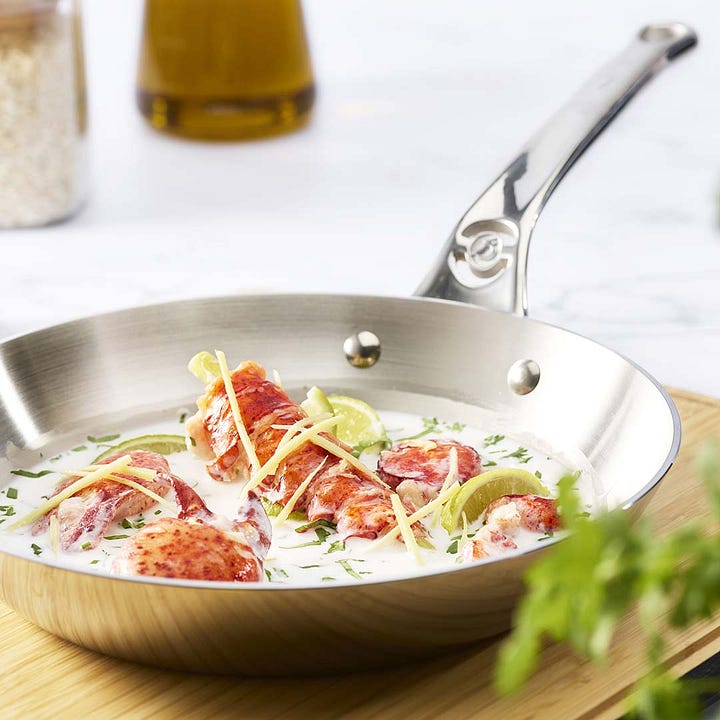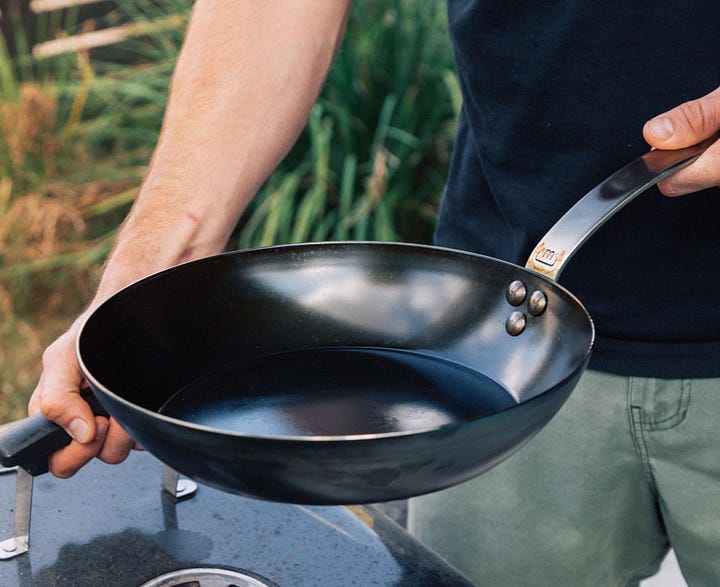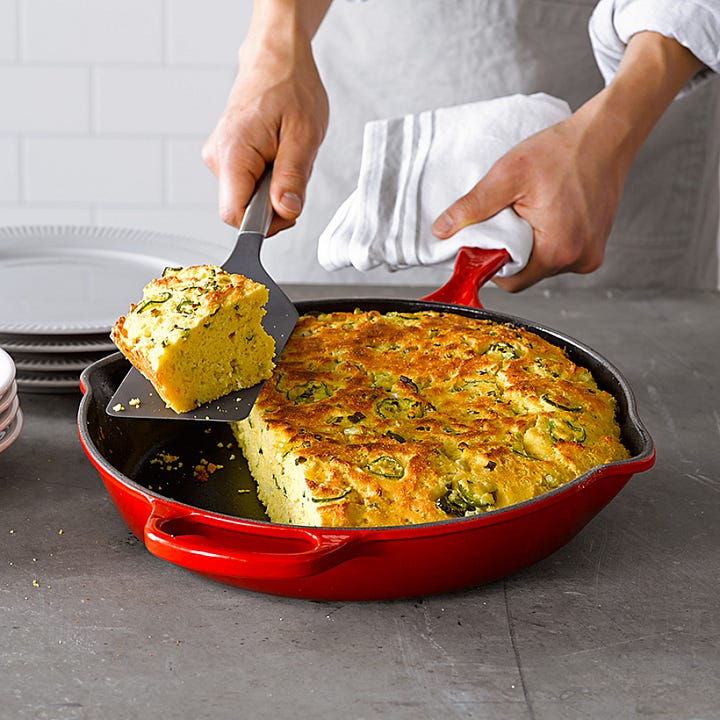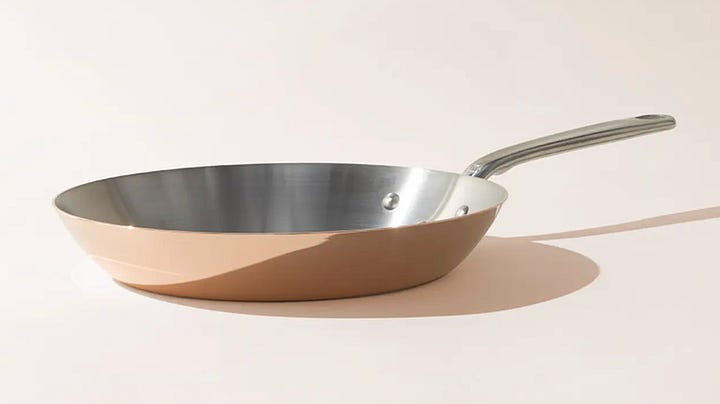Hey, everyone!
Today I’m going to provide a quick overview of various pans and skillets and the differences between them. There’s virtually no functional difference between a pan and a skillet, so I’ll use the terms interchangeably.
A skillet is probably the most-used and thus most important piece of cookware you’ll purchase. I often get asked which of these to buy, and the answer depends a lot on personal preferences and how you plan to use it.
There are a few things you should consider.
The Primary Material
Different pans are made from different primary materials (stainless steel, carbon steel, etc) and this can mean big differences in terms of what you can cook on them and how.
Reactive vs. Non-Reactive
“Reactivity” refers to the tendency of certain materials to react chemically with the food that’s cooked in them. Certain primary materials can react with certain foods (mostly highly acidic ones), and that can affect the flavor of the food and the cookware itself.
Cookware that’s made from reactive materials needs to be more carefully maintained, while non-reactive cookware offers more versatility.
Whether or not it needs to be seasoned
Certain types of cast iron and carbon steel require seasoning— which essentially means they need to have layers of oil “baked” into their surface to create a non-stick layer and prevent rusting.
The seasoning process is less complicated and more forgiving than most people think, but it can add a bit of a learning curve. It also means you need to be more careful with these types of cookware, especially early on.
Performance
Not all cookware performs the same. Certain types of cookware are only suitable for specific types of cooking, some can only be heated to certain temperatures, etc. You should select for cookware that fits your style of cooking and preferred dishes.
With that, let’s get into a few of the most common types of cookware. I’ll cover their advantages and disadvantages, and then at the end I’ll talk about which ones I use most.
As always, feel free to email me or leave a comment if you have any questions!
Myles
Stainless Steel


Stainless steel pans are always my first recommendation for someone looking to upgrade their cookware, especially if they’re just getting started in their cooking journey. But stainless steel pans aren’t just beginners tools— they’re ubiquitous in professional kitchens, as well. I use mine all the time.
When it comes to cost, versatility, performance, and ease of use— nothing beats stainless steel. SS pans are ready to go right out of the box since they don’t require any kind of seasoning process. They’re suitable for stoves or ovens, are non-reactive, and offer the most versatility for cooking. As long as you pre-heat them properly, stainless steel pans can also become virtually non-stick.
If you’re only going to buy just one pan, stainless steel is the best choice.
My recs: Made In, Heritage Steel, De Buyer
Carbon Steel


If you’ve followed this newsletter for a while, you’ve likely heard me sing the praises of carbon steel cookware.
I love carbon steel for a bunch of reasons. In terms of performance, it’s very similar to cast iron— it’s durable, retains heat well, can withstand extremely high heat, and improves over time. But it’s much lighter, and it heats up and cools down a lot faster. This responsiveness to heat makes it really nice to cook with.
The other thing I love about carbon steel pans is the design— a long handle and sloped edges (plus the fact that it’s lightweight) make sauteing and stir-frying really easy.
Carbon steel does require seasoning, but it’s generally quite easy to build up good seasoning. The one downside of carbon steel, as compared to stainless, is versatility. Carbon steel is reactive, so you should try to avoid cooking anything highly acidic, especially early on.
If you’re looking for a pan that gives you the performance of cast iron with more ease of use and versatility, carbon steel is the way to go.
My recs: Made In Blue Carbon Steel
Cast Iron


Cast iron has been around forever and is beloved for a reason. In terms of durability, nothing beats it.
Cast iron performance is comparable to carbon steel in pretty much every way. I prefer carbon steel for the lightness and shape, but I also own a cast iron pan and use it often. Like carbon steel, it’s reactive and requires seasoning. But these pans will last forever if treated well— you can literally pass them along to your grandchildren— and will get better with age.
My recs: Field, Smithey, Butter Pat
Enameled Cast Iron


Enameled cast iron is cast iron that’s had an enamel coating applied to its surface.
The enamel coating changes a lot of things about the cast iron— it no longer requires seasoning, has more non-stick properties right out of the box, is easier to clean, and less prone to rust. BUT, that does come at the expense of durability. Regular cast iron is about the most durable cookware you can buy— enameled cast iron is more prone to cracks and issues that break the coating. It’s also typically more expensive.
If you want cast iron performance but don’t want to deal with seasoning and reactivity, enameled cast iron is a great option.
Ceramic


Ceramic is a material that’s prized for it’s natural non-stick capabilities. It’s one of the few types of non-stick cookware that’s not made using a toxic chemical coating. Plus it’s non-reactive and doesn’t require any seasoning, so it’s versatile and easy to use.
The problem with ceramic is its durability. It can’t be heated above certain temperatures without taking on damage, so you’re limited in terms of what you can cook (you’ll never get a good sear on a steak with ceramic). Even the best ceramic brands also degrade over time— I bought one from Caraway that I still have, but the non-stick surface and performance degraded significantly after about a year.
If you’re looking to transition away from coated non-stick cookware, but aren’t yet ready to make the leap to stainless steel or carbon steel, ceramic is a great choice.
Copper


Copper pans have long been favored by French chefs for their incredible responsiveness to heat. They heat evenly, and they heat up and cool down especially quickly in response to changes in heat. This makes them ideal for certain types of precision cooking.
They don’t require any seasoning, but they are reactive (though in some cases they may be coated with a non-reactive material). They’re also quite expensive.
I like copper pans, and they’re certainly among the most beautiful pieces of cookware you can find. But I don’t own any and rarely use them myself. If your budget is quite high and aesthetics are a top priority, or if you want to add in an additional beautiful piece to complement your existing cookware, copper is a great choice.
What I Use
I own a bunch of different pans (certainly more than the average person needs). But recently I’ve been traveling a lot and was forced to parse down to just the bare essentials.
The two pans that made the cut were my stainless steel and my carbon steel. I like the stainless because of it’s sheer versatility— it’s nice to have at least one non-reactive pan that can handle even highly acidic ingredients. And then I use my carbon steel whenever I want non-stick performance.
I’ve found that I’m able to cook everything I need to with just those two.
Looking for more resources to level up your home cooking?
If you like this newsletter, you’ll love 80/20 Cooking— my online cooking school and community for home cooks. The core program is a four-week bootcamp where you’ll learn principles and techniques that allow you to cook without recipes.
If you’d like to join, you can find more information here!
Thanks for reading!






Nice Article. Thank you. I'm a big fan of cast iron. What are your thoughts on picking up a vintage piece for eBay or something?